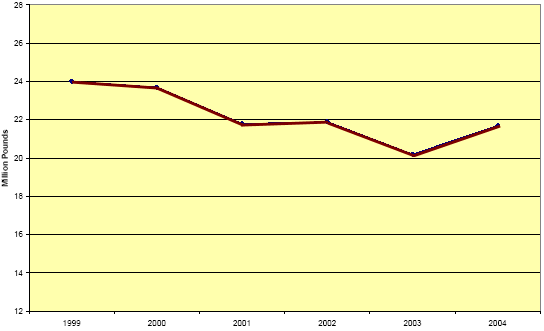



Antibiotic Use in U.S. Animals Rises in 2004
US - Life-saving compounds used to reduce animal pain, suffering and death Washington, D.C., June 27, 2005 . The sales of antibiotics used to treat, prevent and control disease and maintain the health of animals rose 7.5 percent in 2004, according to data provided by the research-based companies that produce animal medicines.
In 2004, 21.7 million pounds of antibiotics were sold for use in farm and companion animals, an increase from 20.2 million pounds sold in 2002. Antibiotic production has trended down since 1999, when 24.4 million pounds were sold. The data were collected from a survey of members of the Animal Health Institute (AHI), consisting of companies that make medicines for pets and farm animals. As antibiotic use has declined, meat production has increased, indicating greater efficiencies being gained by animal producers.
Volume of Antibiotic Sales for Usage in Farm and Companion Animals 1999-2004

“Antibiotic use in animals is a function of the number of animals and the scope of disease outbreaks farmers and ranchers must deal with in their flocks and herds,” said Alexander S. Mathews, AHI President and CEO. “Without these important live-saving antibiotic products, death and suffering among livestock, poultry and companion animals would increase.”
Mathews said the animal health industry is committed to the use of good scientific data as a basis for public policy decisions. The rigorous review process at the Food and Drug Administration was strengthened in late 2003 when the agency added a risk assessment requirement for all antibiotics. New antibiotics as well as those already approved are subject to this requirement. In addition to providing annual data regarding overall use of antibiotics in animals, the industry supports programs like USDA’s Collaboration on Animal Health, Food Safety and Epidemiology, which collects farm-level data and compares antibiotic use patterns to the incidence of antibiotic resistant bacteria at other steps in meat processing. To provide further public health protection, the industry supports the National Antimicrobial Resistance Monitoring System, which provides data on trends in antibiotic resistant bacteria in animals, humans and retail meats.
AHI survey respondents provide an assessment each year of the amount of veterinary antibiotics sold for therapeutic use and health maintenance purposes. The percentage of veterinary antibiotics sales reported as therapeutic was 83 percent in 2001, and has risen each year since, to 91 percent in 2002, 92 percent in 2003 and 95 percent in 2004.
“These data stands in stark contrast to the ‘estimates’ some have offered regarding antibiotic use,” said Mathews. The 5 percent of use attributed to health maintenance represents 1,175,226 pounds of use. Of that amount, 758,969 pounds are compounds with little or no use in human medicine, including ionophores and arsenicals. The remaining 416,257 pounds of use are comprised of four compounds, all of which have been or are being evaluated by risk assessments.

“Antibiotics are being used carefully and judiciously to protect both animal and human health,” said Mathews.
“Risk assessment efforts and resources have been prioritized to address those compounds of greatest concern. To date, those risk assessments have shown miniscule levels of risk that are far outweighed by the benefits to animal and human health.”
Livestock Slaughter and Poultry Slaughter Reports Total U.S. Meat Production

Source: Animal Health Institute - 30th June 2005











